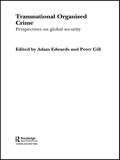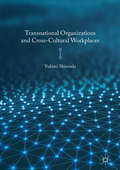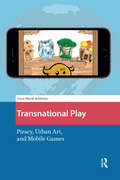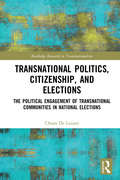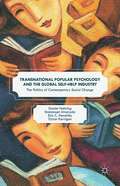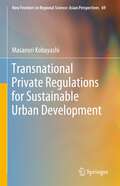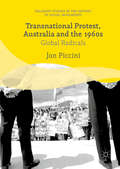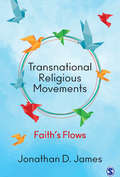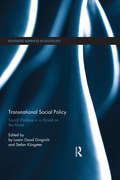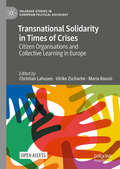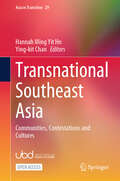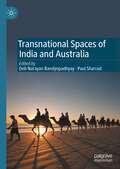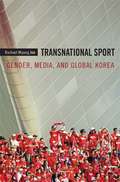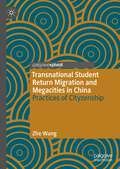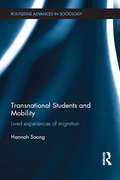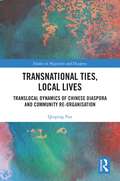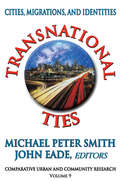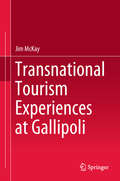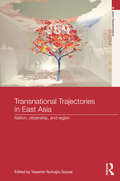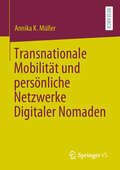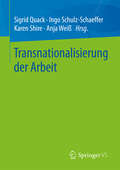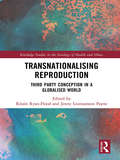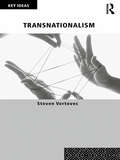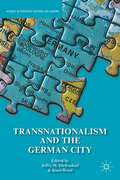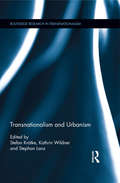- Table View
- List View
Transnational Organised Crime: Perspectives on Global Security (Organizational Crime)
by Peter Gill Adam EdwardsThe perceived threat of 'transnational organized crime' to Western societies has been of huge interest to politicians, policy makers and social scientists over the last decade. This book considers the origins of this crime, how it has been defined and measured and the appropriateness of governments' policy responses. The contributors argue that while serious harm is often caused by transnational criminal activity - for example, the trafficking in human beings - the construction of that criminal activity as an external threat obscures the origins of these crimes in the markets for illicit goods and services within the 'threatened' societies. As such, the authors question the extent to which global crime can be controlled through law enforcement initiatives, and alternative policy initiatives are considered. The authors also question whether transnational organised crime will retain its place on the policy agendas of the United Nations and European Union in the wake of the 'War on Terror'.
Transnational Organizations and Cross-Cultural Workplaces
by Yukimi ShimodaThis work explores everyday face-to-face interactions between expatriate and host national employees in cross-cultural offices of transnational organizations and corporations. Applying the concepts of cosmopolitanism, social capital, and network theory, the book highlights both "closure" and "openness" in interpersonal interactions thus presenting more nuanced ways of understanding employees' transnational business/social connections. It also offers useful suggestions, such as the importance of developing a sense of respect for each other, for those who work in transnational office environments in both home and host societies. The author based her findings on one year of intensive fieldwork in Indonesia, which provides an intimate look at the transnational relationships between Japanese expatriate employees and Indonesian host national co-workers. Social science and international business scholars will embrace this ethnographic study of the relationships formed by these professional migrations.
Transnational Play: Piracy, Urban Art, and Mobile Games (Games and Play)
by Anne-Marie SchleinerTransnational Play approaches gameplay as a set of practices and a global industry that includes diverse participation from players and developers located within the global South, in nations outside of the First World. Players experience play in game cafes, through casual games for regional and global causes like environmentalism, through piracy and cheats, via cultural localization, on their mobile phones, and through urban playful art in Latin America. This book offers a reorientation of perspective on the global developers who make games, as well as the players who consume games, while still acknowledging geographically distributed socioeconomic, racial, gender, and other inequities. Over the course of the inquiry, which includes a chapter dedicated to the cartography of the mobile augmented reality game Pokémon Go, the author develops a theoretical line of argument critically informed by gender studies and intersectionality, postcolonialism, geopolitics, and game studies, problematizing play as a diverse and contested transnational domain.
Transnational Politics, Citizenship and Elections: The Political Engagement of Transnational Communities in National Elections (Routledge Research in Transnationalism)
by Chiara De LazzariThis book examines the reasons for which political parties engage with transnational communities and consider the engagement of expatriate communities to be of value or, otherwise, for domestic politics. Centred on Italy, and offering comparative analyses of external voting policies in other countries, such as Turkey and Romania, it draws on interview material with representatives of major political parties and members of state institutions to consider why parties value the political engagement of citizens living abroad. With attention to citizenship policies and the motivations that guide policy makers to introduce external voting policies in countries of origin, the author raises questions about the legitimacy of political engagement on the part of diasporic communities and asks how we should best understand the implementation of certain types of domestic citizenship policy. As such, Transnational Politics, Citizenship, and Elections will appeal to scholars of sociology and politics with interests in transnationalism and the engagement of expatriate populations in the domestic politics of their countries of origin.
Transnational Popular Psychology and the Global Self-Help Industry: The Politics of Contemporary Social Change
by Daniel Nehring Dylan Kerrigan Emmanuel Alvarado Eric C. HendriksSelf-help books aim to empower their readers and deliver happiness and personal fulfilment but do they really live up to this? This book offers a fresh perspective on self-help culture and popular psychology. Research on this subject matter has generally focused on the USA and the Global Northwest. In contrast, this book explores the production, circulation and consumption of self-help books from an innovative transnational perspective. Case studies on Trinidad, Mexico, the People's Republic of China, the UK and the USA explore the roles which self-help's therapeutic narratives of self and social relationships play in the contemporary world. In this context, the book questions the extent to which self-help fulfils its promise of individual autonomy and contentment. At the same time, it addresses debates about contemporary political change under transnational processes of cultural standardization.
Transnational Private Regulations for Sustainable Urban Development (New Frontiers in Regional Science: Asian Perspectives #69)
by Masanori KobayashiThis book analyzes the mechanism of transnational private regulations (TPRs) in the global property investment market and the conditions of their effectiveness for sustainable urban development. In the present economy, with control over national legislation alone, state policymakers have been challenged to regulate transnational investors, markets, and issues such as global warming, financial crises, food safety risks, deforestation, and cross-border business transactions. Transgovernmental networks of regulators have assembled representatives and technical experts from national regulatory agencies, nongovernmental organizations, private firms, and business organizations. As private corporations become increasingly globalized, many forms of TPRs have emerged since the 1990s for legislation, standard-setting, monitoring of compliance, and implementation of transnational rules, to respond to challenges posed by the transformation of domestic and international regulatory environments. TPRs are self-regulated, non-state, market-driven regulations. Since the emergence of TPRs, the global rule-making landscape has become dynamic. Urban development and property investment have been viewed historically as local phenomena: The regulations and standards in this field have been established and enforced by governments, local associations, and national professional bodies. However, as urban development and property investment increasingly have been globalized, the services, transactions, and investments by private firms have transcended national boundaries. For this reason, it has become difficult for states to regulate global activities through existing national legislation or international regulatory systems. As the management of new transnational issues through collaborations between various actors is unpredictable, it is necessary to examine the mechanism of TPRs in global property investment and their effectiveness for sustainable urban development.
Transnational Protest, Australia and the 1960s (Palgrave Studies in the History of Social Movements)
by Jon PicciniAustralia is rarely considered to have been a part of the great political changes that swept the world in the 1960s: the struggles of the American civil rights movement, student revolts in Europe, guerrilla struggles across the Third World and demands for women's and gay liberation. This book tells the story of how Australian activists from a diversity of movements read about, borrowed from, physically encountered and critiqued overseas manifestations of these rebellions, as well as locating the impact of radical visitors to the nation. It situates Australian protest and reform movements within a properly global - and particularly Asian - context, where Australian protestors sought answers, utopias and allies. Dramatically broadens our understanding of Australian protest movements, this book presents them not only as manifestations of local issues and causes but as fundamentally tied to ideas, developments and personalities overseas, particularly to socialist states and struggles in near neighbours like Vietnam, Malaysia and China. 'Jon Piccini is Research and Teaching Fellow at The University of Queensland, Brisbane, Australia. His research interests include the history of human rights and social histories of international student migration. '
Transnational Religious Movements: Faith’s Flows
by Jonathan D JamesThis book studies the concepts and philosophies governing globalized faiths. Transnational Religious Movements is a convincing narrative of how global religions have moved beyond spirituality to become key players in the world of welfare, education, economics, politics, and international relations. It examines the major faiths of the world, viz., Christianity, Islam, Buddhism, and a sect. of Hinduism, to demonstrate transnational religious movements in the wake of globalization. The book focuses on the strategies and practices of six representative religious organizations that operate transnationally and helps us understand how they are formed, structured, and institutionalized in society, and how they operate. It dwells on how individuals, groups, media, and state as well as non-state actors come to terms with these organizations. World religions do not simply respond to globalization; they also shape and affect the future dynamics of globalization.
Transnational Social Policy: Social Welfare in a World on the Move (Routledge Advances in Sociology)
by Luann Good Gingrich Stefan KöngeterTransnational Social Policy highlights the changing face of social policy and social work against the background of accelerating transnationalization of economies, labour markets, education, social services, and care. The contributions of this book provide unique case examples on the interplay of social policies, mobile populations, and travelling knowledge about welfare within an increasingly asymmetrical global context. This innovative volume also includes historical studies on the transformations of social policies during the last century and reflects the developments of social welfare across the Global North and the Global South. With its emphasis on theoretical assumptions of policy translation, the case studies show the importance of adjustments, negotiations, and participation of various actors in the transnational social field of welfare production. Thus, within ever-shifting contexts of new political agendas promoting the free play of the market and a neoliberal agenda of competition and austerity, this insightful book reveals new transnational forms of social exclusion that function within, across, and in-between nation-states. Presenting a major and much needed addition to current discussions on globalization and the increasing complexity of worldwide social relations, this volume will be of interest to scholars and graduate students interested in fields such as Social Policy, Social Work, Public Administration, Development Studies, Political Science, and Sociology, as well as many interdisciplinary fields including Global Studies, International Development Studies, and Immigration and Settlement Studies.
Transnational Solidarity in Times of Crises: Citizen Organisations and Collective Learning in Europe (Palgrave Studies in European Political Sociology)
by Christian Lahusen Maria Kousis Ulrike ZschacheThis open access collection is devoted to an in-depth, qualitative analysis of practices of cross-national solidarity in response to the current political and social crises, from citizens’ initiatives to networks of cooperation among civil society actors. The book analyses existing informal groups at the grassroots, furthering transnational solidarity in three thematic areas: disability, unemployment and immigration. Contributions assess how civic groups respond to the various crises affecting Europe, especially the economic and refugee crises, presenting new findings from a systematic comparative study conducted in eight European countries (Denmark, France, Germany, Greece, Italy, Poland, Switzerland, and the UK). The research will be of interest to scholars, students, journalists, policy-makers and activists interested in civil society, social movements, charitable actions, altruism and solidarity, as well as European studies and the socio-economic challenges of current European crises.
Transnational Southeast Asia: Communities, Contestations and Cultures (Asia in Transition #29)
by Hannah Ming Yit Ho Ying-Kit ChanThis open access book presents Southeast Asia as an interesting and conceptually meaningful site to interrogate the transnational paradigm. In featuring research from and across different nations in Southeast Asia, it asks in what ways Southeast Asia lends itself to nuanced applications of transnationalism, and what the wider cultural and collective implications of that might be. Instead of viewing the past and the present as oppositional concepts of time, a temporal continuum is applied to a time-space compression that is fundamental to the workings of the transnational paradigm in the region that we call Southeast Asia. The transnational paradigm, a conceptual tool encompassing various configurations of transnationalism across disciplines, becomes relevant for analysing global cultural flows, but not without due consideration of the nuances shaped by spatio-temporal trends. A paradigm shift in transnationalism from historical connections to contemporary connectivity is afforded by increased mobility and accelerated cultural flows, which have given rise to unprecedented economic productivity in the past century and digital connectivity in the new millennium – a shift that the chapters collectively explore. Relevant to advanced students and scholars across disciplines in the humanities and social sciences, focused on Southeast Asia, this book is a timely exploration that unpicks and unpacks this long-discussed aspect within Asian &‘area studies&’.
Transnational Spaces of India and Australia
by Paul Sharrad Deb Narayan BandyopadhyayTransnational movements are more intricate than diasporic conflicts of ‘home and away’. They operate not only as international connections but also transect and disturb national formations. What are the spaces (both physical and temporal) in and around which transnational exchanges occur? Much discussion of the transnational focuses on international movements of law, politics and economics as they relate to Europe and the Americas. This book extends the focus to dynamics across the humanities and social sciences and concentrates on the historical and now growing interactions between India and Australia. Studies come from scholars in both countries, who combine academic depth for students and researchers and writing that is clear and engaging for the general reader.
Transnational Sport: Gender, Media, and Global Korea
by Rachael Miyung JooBased on ethnographic research in Seoul and Los Angeles, Transnational Sport tells how sports shape experiences of global Koreanness, and how those experiences are affected by national cultures. Rachael Miyung Joo focuses on superstar Korean athletes and sporting events produced for transnational media consumption. She explains how Korean athletes who achieve success on the world stage represent a powerful, globalized Korea for Koreans within the country and those in the diaspora. Celebrity Korean women athletes are highly visible in the Ladies Professional Golf Association. In the media, these young golfers are represented as daughters to be protected within the patriarchal Korean family and as hypersexualized Asian women with commercial appeal. Meanwhile, the hard-muscled bodies of male athletes, such as Korean baseball and soccer players, symbolize Korean masculine dominance in the global capitalist arena. Turning from particular athletes to a mega-event, Joo discusses the 2002 FIFA World Cup Korea/Japan, a watershed moment in recent Korean history. New ideas of global Koreanness coalesced around this momentous event. Women and youth assumed newly prominent roles in Korean culture, and, Joo suggests, new models of public culture emerged as thousands of individuals were joined by a shared purpose.
Transnational Student Return Migration and Megacities in China: Practices of Cityzenship
by Zhe WangThis book is a study of the return migration of overseas Chinese students. By 2018, over 3.5 million Chinese students had returned from overseas universities to China, with the megacities of Beijing, Shanghai, and Shenzhen representing by far their main destinations. In other words, when overseas students return to China, many do not return to their hometown but usually land, work and settle down in Beijing, Shanghai and Shenzhen. Their return migration is thus not only transnational, but also internal-urban. This book adopts a multi-level geographical analysis to explore this important phenomenon, exploring why and how returnees choose these three cities and how they experience and interpret their everyday lives in these megacities after their return. In doing so, it highlights the importance of cultural logics and multiscalar thinking of transnational Chinese students’ return migration and illuminates how their transnational migration reproduces domestic socio-spatial inequalities. This book brings an important contribution to the fields of Cultural Geography, Urban Geography, Transnationalism, Migration Studies and Citizenship Studies.
Transnational Students and Mobility: Lived Experiences of Migration (Routledge Advances in Sociology)
by Hannah SoongAs globalisation deepens, student mobility and migration has not only impacted economy and institutions, it has also infused human desires, imaginaries, experiences and subjectivities. In Transnational Students and Mobility, Hannah Soong portrays the vexed nexus of education and migration as a site of multiple tensions and existence and examines how the notion of imagined mobility through education-migration nexus transforms the social value of international education and transnational mobility.
Transnational Ties, Local Lives: Translocal Dynamics of Chinese Diaspora and Community Re-organisation (Studies in Migration and Diaspora)
by Qiuping PanTransnational Ties, Local Lives: Translocal Dynamics of Chinese Diaspora and Community Re-organisation delves into the evolving civic life and organisational structures of Chinese diaspora communities. Drawing on rich, multi-method ethnographic research in Australia, this book unveils the dynamic ways ethnic Chinese communities self-organise, offering a new theoretical framework to dissect the dimensions, scope, and essence of their re-organisation efforts and the wider implications thereof.This work enriches our comprehension of the local and global influence of Chinese immigrants and their associations in the contemporary era. It serves as a valuable reference for scholars and students interested in migration, diaspora studies, and the role of ethnic and migrant organisations in civic life and community building. Transnational Ties, Local Lives provides a critical examination of the intricate relationships between identity, belonging, and community in a globalised world.This engaging book presents a bottom-up perspective on the personal dreams and realities of migrants who establish their lives and homes in new countries. It encapsulates the spirit of change and resilience, crafting a story that echoes the diverse experiences of diaspora communities across the globe.
Transnational Ties: Cities, Migrations, and Identities (Comparative Urban And Community Research Ser.)
by John Eade Michael Peter SmithCities are key sites of the transnational ties that increasingly connect people, places, and projects across the globe. They provide opportunities and constraints within which transnational actors and networks operate and nodes linking wider social formations traverse national borders. This book brings together a series of richly textured ethnographic studies that suggest new ways to situate and historicize transnationalism, identify new pathways to transnational urbanism, and map the contours of translocal, interregional, and diasporic connections not previously studied. The transnational ties treated in this book truly span the globe, giving concrete meaning to the phrase "globalization from below."How have the contributors to this book conceptualized the wider context informing the conduct of their ethnographically grounded, multi-sited research on the relationship between cities, migration, and transnationalism? Several interrelated contextual dimensions have been singled out as affecting the opportunities and constraints experienced by transnational migrant subjects. Socio-spatially, in several of these chapters, the political economic context now called neoliberal globalization is shown to be a key driving force creating conditions that necessitate, facilitate, or impede migration, foster trans-local economic ties, and create new inter-regional interdependencies--e.g., new South-South and East-East transnational ties.The changing historical context of both migrating groups and the cities and regions they move across are central to the study of the interplay of urban change and migrant transnationalism. The historical particularities of migrant recruitment, migration histories, migratory narratives, and changing gender and class relations all affect the character and geography of transnational migration with an impact on the social structures of community formation. This is a pioneering effort in the Comparative Urban and Community Research series.
Transnational Tourism Experiences at Gallipoli
by Jim McKayThis book offers a fresh account of the Anzac myth and the bittersweet emotional experience of Gallipoli tourists. Challenging the straightforward view of the Anzac obsession as a kind of nationalistic military Halloween, it shows how transnational developments in tourism and commemoration have created the conditions for a complex, dissonant emotional experience of sadness, humility, anger, pride and empathy among Anzac tourists. Drawing on the in-depth testimonies of travellers from Australia and New Zealand, McKay shines a new and more complex light on the history and cultural politics of the Anzac myth. As well as making a ground breaking, empirically-based intervention into the culture wars, this book offers new insights into the global memory boom and transnational developments in backpacker tourism, sports tourism and “dark” or “dissonant” tourism.
Transnational Trajectories in East Asia: Nation, Citizenship, and Region (Asia's Transformations)
by Yasemin Nuhoḡlu SoysalIn recent decades, East Asia has become increasingly interconnected through trade, investment, migration, and popular culture at regional and global levels. At the same time, the region has seen renewed national assertiveness and nationalist impulses. The book interrogates these seemingly contradictory developments as they bear on the transformations of the nation and citizenship in East Asia. Conventionally, studies on East Asia juxtapose these developments, focusing on the much-exercised dichotomy of the national and transnational. In contrast, this book suggests a different orientation. First, it moves beyond the simplistic view that demarcates the transnational as "the West". Second, it does not view the national and transnational as distinct or contradictory spheres of influence and analysis, but rather, focuses on the interactions between the two, with a view on how these interactions work to transform the ideals and practices of the "good nation", "good society", and "good citizen". The chapters cover a broad range of empirical research--education, science, immigration, multicultural policy, human rights, gender and youth orientations, art and food flows, politics of values and regional identity--which highlight the ways in which the nation is reconfigured, and the relationship between the citizen and (national) collective is redefined, in relation to transnational dynamics and frameworks. Transnational Trajectories in East Asia provides a new perspective on and original analysis of transnational processes, bringing a fresh understanding to developments of the nation and citizenship in the region. It will be of great interest to students and scholars of transnationalization and globalization; comparative citizenship, migration, and multiculturalism; and Asian politics, society, and regionalism.
Transnationale Mobilität und persönliche Netzwerke Digitaler Nomaden
by Annika K. MüllerIn der vorliegenden Studie bietet Annika Müller detaillierte Einblicke in die Lebenswelt Digitaler Nomaden. Diesen onlinebasiert arbeitenden und ortsflexibel lebenden Personen wurde in der sozialwissenschaftlichen Forschung bislang nur wenig Aufmerksamkeit geschenkt. Auf Basis eines qualitativen netzwerkanalytischen Forschungsansatzes widmet sich die Autorin daher mit einem differenzierten Blick deren Mobilitätspraktiken, Arbeitsgewohnheiten und sozialen Eingebundenheit. Sie begegnet den postmodernen Nomaden in verschiedenen Ländern Südostasiens – häufig in coworking- und coliving Spaces – und lässt sie in Interviews selbst zu Wort kommen. Es wird gezeigt, dass die befragten Akteur*innen ihre ganz eigenen Mobilitätsstrategien entwickeln und soziale Eingebundenheit jenseits nationalstaatlicher Grenzen herstellen.
Transnationalisierung der Arbeit
by Sigrid Quack Anja Weiß Ingo Schulz-Schaeffer Karen ShireDie Beiträge in diesem Band entwickeln eine neuartige Perspektive auf Arbeit und Arbeitsmärkte, welche den nationalstaatlichen Referenzrahmen überschreitet. Drei Phänomene sind für die Transnationalisierung von Arbeit von besonderer Bedeutung: (1) die grenzüberschreitende Mobilität von Arbeitskräften, (2) die grenzüberschreitende Mobilität von Arbeitstätigkeiten und Wissen, die teilweise, aber nicht zwangsläufig mit einer Verlagerung der Produktionsstandorte verbunden ist, und (3) die Herausbildung europäischer, transnationaler und globaler Institutionen, in welche die grenzüberschreitende Mobilität von Arbeitskräften, Arbeitstätigkeiten und Wissen zunehmend eingebettet ist.
Transnationalising Reproduction: Third Party Conception in a Globalised World
by Roisin Ryan Flood Jenny Gunnarsson PayneThird party conception is a growing phenomenon and provokes a burgeoning range of ethical, legal and social questions. What are the rights of donors, recipients and donor conceived children? How are these reproductive technologies regulated? How is kinship understood within these new family forms? Written by specialists from three different continents, Transnationalising Reproduction examines a broad range of issues concerning kinship and identity, citizenship and regulation, and global markets of reproductive labour; including gamete donation and gestational surrogacy. Indeed, this book seeks to highlight how reproductive technologies not only makes possible new forms of kinship and family formations, but also how these give rise to new, ethical, political and legal dilemmas about parenthood as well as new modes of discrimination and a re-distribution of medical risks. It also thoroughly investigates the ways in which a commodification of reproductive tissue and labour affects the practices, representations and gendered self-understandings of gamete donors, fertility patients and intended parents in different parts of the world. With a broad geographical scope, Transnationalising Reproduction offers new empirical and theoretical perspectives on third-party conception and demonstrates the need for more transnational approaches to third-party reproduction. This volume will appeal to postgraduate students and postdoctoral researchers interested in fields such as Gender Studies, Health Care Sciences, Reproductive Technology and Medical Sociology.
Transnationalism (Key Ideas #Vol. 9)
by Steven Vertovec'Transnationalism' refers to multiple ties and interactions linking people or institutions across the borders of nation-states. This book surveys the broader meanings of transnationalism within the study of globalization before concentrating on migrant transnational practices. Each chapter demonstrates ways in which new and contemporary transnational practices of migrants are fundamentally transforming social, political and economic structures simultaneously within homelands and places of settlement. Transnationalism provides a much-needed single, clear and condensed text concerning a major concept in academic and policy discourse today. The book is for advanced undergraduate students, postgraduates and academics.
Transnationalism And The German City
by Janet Ward Jeffry M. DiefendorfToo often, scholars treat transnationalism as a conflict in which the local, regional, and national give way to globalized identity. As these varied studies of German cities show, though, the urban environment is actually a site of trans-localism that is not merely oppositional, but that adapts itself dialectically to the forces of globalization.
Transnationalism and Urbanism (Routledge Research in Transnationalism)
by Stefan Krätke Kathrin Wildner Stephan LanzThe formation of transnational urban spaces is a relevant and challenging field of interdisciplinary research, which deserves much more debate in order to deepen our understanding of generating and restructuring urban spaces under conditions of contemporary globalisation processes. This edited collection reflects current studies on the relation of transnationalism and urbanism. Scholars from disciplines including Geography, Ethnography and Urban Planning discuss theoretical approaches, methodology and case studies on processes of the production of urban spaces through global economic value chains, socio-cultural practices, and political governance strategies. Cities are appropriate sites for an examination of the spatial dimension of transnationality because this is where global processes are concentrated, localized, transformed and materialize. In this context, urban space is not merely to be regarded as a setting for transnational practices, but as a constituent force of transnationalism in all its manifestations.
